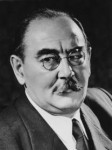 Imre Nagy (1896-1958) was a Hungarian socialist politician and a significant leader of the 1956 Hungarian Uprising. He was executed for his involvement in this uprising. Born in western Hungary to a poor family, Nagy joined the Austro-Hungarian army in 1915 and fought against the Russians in World War I. In 1916 he was captured and detained in Russia for the rest of the war. During this period he became a communist after being exposed to the ideas of Marx and Lenin. Nagy remained in the Soviet Union between the wars, where he received a Marxist education, served with the Red Army and participated in the Russian Civil War. He returned to Hungary in 1921 and attempted to incite a communist movement there. Unsuccessful, he returned to the Soviet Union in 1930.
Imre Nagy (1896-1958) was a Hungarian socialist politician and a significant leader of the 1956 Hungarian Uprising. He was executed for his involvement in this uprising. Born in western Hungary to a poor family, Nagy joined the Austro-Hungarian army in 1915 and fought against the Russians in World War I. In 1916 he was captured and detained in Russia for the rest of the war. During this period he became a communist after being exposed to the ideas of Marx and Lenin. Nagy remained in the Soviet Union between the wars, where he received a Marxist education, served with the Red Army and participated in the Russian Civil War. He returned to Hungary in 1921 and attempted to incite a communist movement there. Unsuccessful, he returned to the Soviet Union in 1930.
After World War II Nagy returned to Hungary. He held several positions in the pro-Soviet government there, including ministerial portfolios in agriculture, food and the interior. Nagy oversaw much need land reforms, redistributing land to local peasants. In July 1953 Nagy became the prime minister of Hungary, replacing hardline Stalinist Matyas Rakosi. Nagy’s government developed what it called a “New Course” of socialist policy, designed to slow the pace of industrialism and allow breathing space for the Hungarian people. This deviation from Soviet economic policy led to Nagy’s removal from the prime ministership in April 1955, however, his humanism and flexible approach to socialism remained popular with many Hungarians. In October 1956 growing public dissatisfaction with Soviet socialism returned Nagy to the prime ministership and sparked the Hungarian Uprising. Within days Nagy had made public statements calling for the restoration of democratic government, the abolition of the secret police (AVH) and the removal of Soviet troops from Hungarian soil. On November 1st he announced his intention to withdraw Hungary from the Warsaw Pact.
This announcement, along with the growing violence in Budapest, forced Moscow to act. Soviet troops invaded Hungary on November 4th and crushed the uprising, killing between 2,000 and 3,000 people. Nagy himself took refuge in the relative safety of the Yugoslavian embassy. He walked out of the embassy three weeks later, having been promised safe conduct out of Hungary, but was immediately arrested by Soviet authorities. Nagy was detained in Romania for several months then returned to Hungary, where a new regime loyal to Moscow had been installed. Nagy was tried in secret and hanged in June 1958. The Hungarian people were only made aware of his fate after Nagy had been executed.
Content on this page is © Alpha History 2018-23. This content may not be republished or distributed without permission. For more information please refer to our Terms of Use.
This page was written by Jennifer Llewellyn and Steve Thompson. To reference this page, use the following citation:
J. Llewellyn & S. Thompson, “Imre Nagy”, Alpha History, accessed [today’s date], https://alphahistory.com/coldwar/imre-nagy/.
